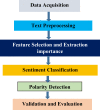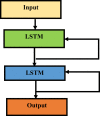An efficient hybrid stock trend prediction system during COVID-19 pandemic based on stacked-LSTM and news sentiment analysis
- PMID: 36467438
- PMCID: PMC9702704
- DOI: 10.1007/s11042-022-14216-w
An efficient hybrid stock trend prediction system during COVID-19 pandemic based on stacked-LSTM and news sentiment analysis
Abstract
The coronavirus is an irresistible virus that generally influences the respiratory framework. It has an effective impact on the global economy specifically, on the financial movement of stock markets. Recently, an accurate stock market prediction has been of great interest to investors. A sudden change in the stock movement due to COVID -19 appearance causes some problems for investors. From this point, we propose an efficient system that applies sentiment analysis of COVID-19 news and articles to extract the final impact of COVID-19 on the financial stock market. In this paper, we propose a stock market prediction system that extracts the stock movement with the COVID spread. It is important to predict the effect of these diseases on the economy to be ready for any disease change and protect our economy. In this paper, we apply sentimental analysis to stock news headlines to predict the daily future trend of stock in the COVID-19 period. Also, we use machine learning classifiers to predict the final impact of COVID-19 on some stocks such as TSLA, AMZ, and GOOG stock. For improving the performance and quality of future trend predictions, feature selection and spam tweet reduction are performed on the data sets. Finally, our proposed system is a hybrid system that applies text mining on social media data mining on the historical stock dataset to improve the whole prediction performance. The proposed system predicts stock movement for TSLA, AMZ, and GOOG with average prediction accuracy of 90%, 91.6%, and 92.3% respectively.
Keywords: COVID-19 pandemic; Machine learning; Prediction; Sentimental analysis; Stacked-LSTM; Stock market.
© The Author(s) 2022.
Conflict of interest statement
Conflict of interestThe authors declare that they have no conflict of interest.
Figures

















Similar articles
-
Effect of public sentiment on stock market movement prediction during the COVID-19 outbreak.Soc Netw Anal Min. 2022;12(1):92. doi: 10.1007/s13278-022-00919-3. Epub 2022 Jul 27. Soc Netw Anal Min. 2022. PMID: 35911484 Free PMC article.
-
A cooperative deep learning model for stock market prediction using deep autoencoder and sentiment analysis.PeerJ Comput Sci. 2022 Nov 30;8:e1158. doi: 10.7717/peerj-cs.1158. eCollection 2022. PeerJ Comput Sci. 2022. PMID: 36532805 Free PMC article.
-
Stock price movement prediction based on Stocktwits investor sentiment using FinBERT and ensemble SVM.PeerJ Comput Sci. 2023 Jun 7;9:e1403. doi: 10.7717/peerj-cs.1403. eCollection 2023. PeerJ Comput Sci. 2023. PMID: 37346695 Free PMC article.
-
Survey of feature selection and extraction techniques for stock market prediction.Financ Innov. 2023;9(1):26. doi: 10.1186/s40854-022-00441-7. Epub 2023 Jan 12. Financ Innov. 2023. PMID: 36687795 Free PMC article. Review.
-
Modeling of Machine Learning-Based Extreme Value Theory in Stock Investment Risk Prediction: A Systematic Literature Review.Big Data. 2025 Jun;13(3):161-180. doi: 10.1089/big.2023.0004. Epub 2024 Jan 17. Big Data. 2025. PMID: 38232710
References
-
- Alessia D et al. (2015) Approaches, tools and applications for sentiment analysis implementation. Int J Comput Appl. 125.3
-
- Ananthi M, Vijayakumar K (2020) Stock market analysis using candlestick regression and market trend prediction (CKRM). J Amb Intell Human Comput. 1–8. 2_11
Publication types
LinkOut - more resources
Full Text Sources
